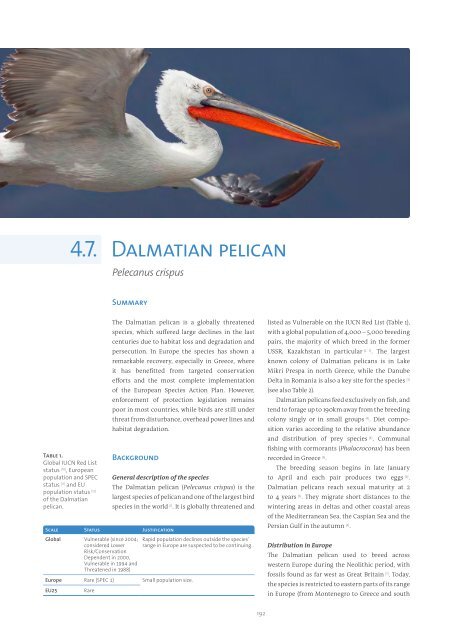130925-studie-wildlife-comeback-in-europe
You also want an ePaper? Increase the reach of your titles
YUMPU automatically turns print PDFs into web optimized ePapers that Google loves.
4.7. Dalmatian pelican<br />
Pelecanus crispus<br />
Summary<br />
Table 1.<br />
Global IUCN Red List<br />
status [10] , European<br />
population and SPEC<br />
status [11] and EU<br />
population status [12]<br />
of the Dalmatian<br />
pelican.<br />
The Dalmatian pelican is a globally threatened<br />
species, which suffered large decl<strong>in</strong>es <strong>in</strong> the last<br />
centuries due to habitat loss and degradation and<br />
persecution. In Europe the species has shown a<br />
remarkable recovery, especially <strong>in</strong> Greece, where<br />
it has benefitted from targeted conservation<br />
efforts and the most complete implementation<br />
of the European Species Action Plan. However,<br />
enforcement of protection legislation rema<strong>in</strong>s<br />
poor <strong>in</strong> most countries, while birds are still under<br />
threat from disturbance, overhead power l<strong>in</strong>es and<br />
habitat degradation.<br />
Background<br />
Scale Status Justification<br />
Global Vulnerable (s<strong>in</strong>ce 2004;<br />
considered Lower<br />
Risk/Conservation<br />
Dependent <strong>in</strong> 2000,<br />
Vulnerable <strong>in</strong> 1994 and<br />
Threatened <strong>in</strong> 1988)<br />
General description of the species<br />
The Dalmatian pelican (Pelecanus crispus) is the<br />
largest species of pelican and one of the largest bird<br />
species <strong>in</strong> the world [1] . It is globally threatened and<br />
Europe Rare (SPEC 1) Small population size.<br />
EU25<br />
Rare<br />
Rapid population decl<strong>in</strong>es outside the species’<br />
range <strong>in</strong> Europe are suspected to be cont<strong>in</strong>u<strong>in</strong>g.<br />
listed as Vulnerable on the IUCN Red List (Table 1),<br />
with a global population of 4,000 – 5,000 breed<strong>in</strong>g<br />
pairs, the majority of which breed <strong>in</strong> the former<br />
USSR, Kazakhstan <strong>in</strong> particular [2, 3] . The largest<br />
known colony of Dalmatian pelicans is <strong>in</strong> Lake<br />
Mikri Prespa <strong>in</strong> north Greece, while the Danube<br />
Delta <strong>in</strong> Romania is also a key site for the species [3]<br />
(see also Table 2).<br />
Dalmatian pelicans feed exclusively on fish, and<br />
tend to forage up to 190km away from the breed<strong>in</strong>g<br />
colony s<strong>in</strong>gly or <strong>in</strong> small groups [4] . Diet composition<br />
varies accord<strong>in</strong>g to the relative abundance<br />
and distribution of prey species [4] . Communal<br />
fish<strong>in</strong>g with cormorants (Phalacrocorax) has been<br />
recorded <strong>in</strong> Greece [5] .<br />
The breed<strong>in</strong>g season beg<strong>in</strong>s <strong>in</strong> late January<br />
to April and each pair produces two eggs [6] .<br />
Dalmatian pelicans reach sexual maturity at 2<br />
to 4 years [6] . They migrate short distances to the<br />
w<strong>in</strong>ter<strong>in</strong>g areas <strong>in</strong> deltas and other coastal areas<br />
of the Mediterranean Sea, the Caspian Sea and the<br />
Persian Gulf <strong>in</strong> the autumn [4] .<br />
Distribution <strong>in</strong> Europe<br />
The Dalmatian pelican used to breed across<br />
western Europe dur<strong>in</strong>g the Neolithic period, with<br />
fossils found as far west as Great Brita<strong>in</strong> [7] . Today,<br />
the species is restricted to eastern parts of its range<br />
<strong>in</strong> Europe (from Montenegro to Greece and south<br />
192


